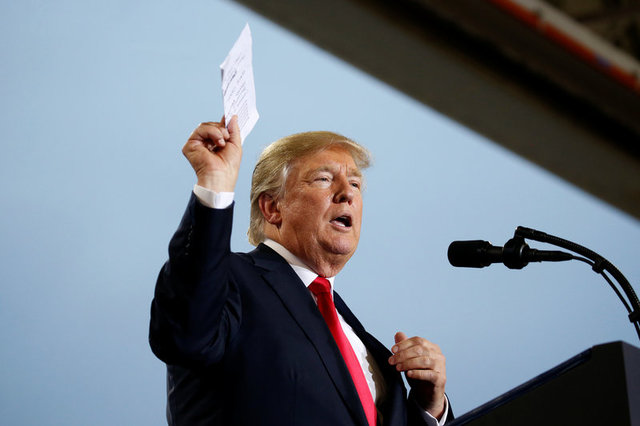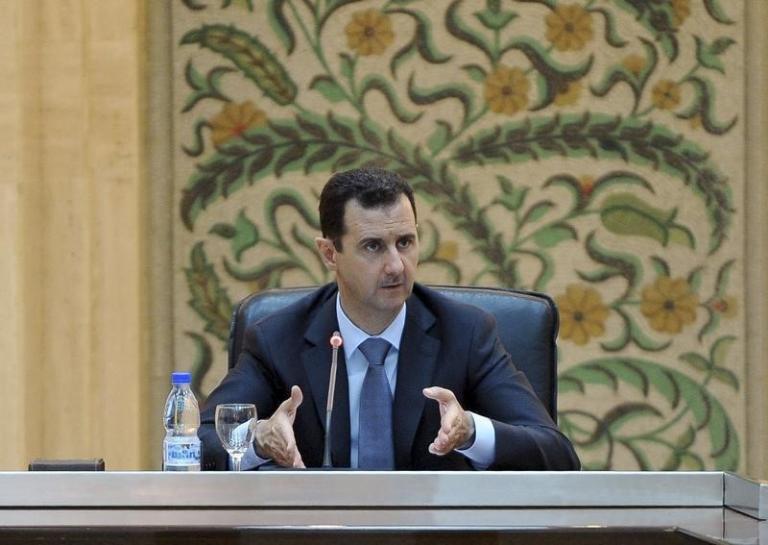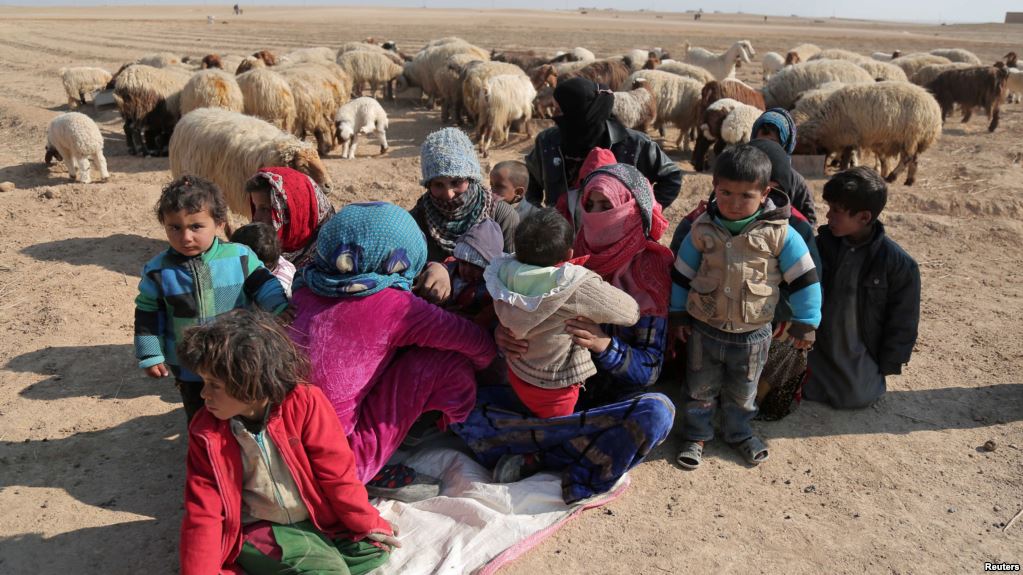The end of the caliphate has opened fresh sectarian, ethnic and political fault lines that will suffuse the region in harsh competitions and conflicts for years to come.
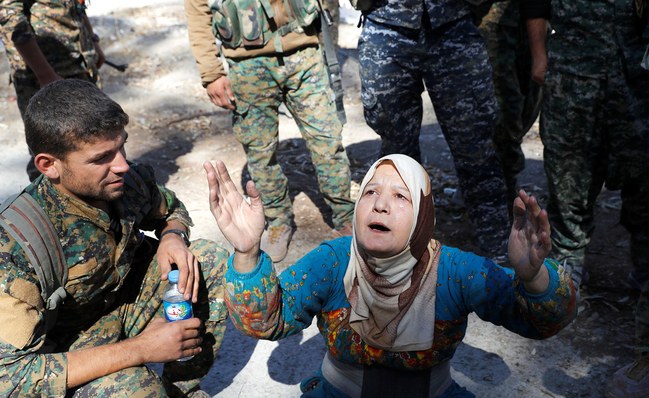
A civilian prays after she was rescued by fighters of Syrian Democratic Forces after Raqqa was liberated. Credit: Reuters
On October 17, elements of the US-backed Syrian Democratic Forces (SDF) paraded through Paradise Square of Raqqa town, declaring the end of the control of ISIS over its “capital” in Syria. This followed the earlier capture of Mosul – ISIS’s capital in Iraq – by Iraqi forces in June. While there are still some pockets of ISIS resistance in Raqqa and parts of Iraq, the ISIS’s ‘caliphate’ has ceased to exist, just three years after it had been proclaimed from the pulpit of the mosque in Mosul by its self-styled caliph, Abū Bakr al-Baghdadi.
At its peak two years ago, the caliphate had territory the size of Britain and a population of nine million, similar to that of Jordan. It had an army of over 100,000, income of several million dollars annually from oil sales and ransom and a functioning government, with ministers, provincial heads, security, bureaucratic and municipal personnel, a judiciary, finance and education departments and even a marriage counselling setup. Besides its core cadres from Iraq and Syria, it had attracted 40,000 foreign fighters from over hundred countries.
Anti-ISIS coalition
ISIS had controlled Raqqa for three years, gaining notoriety for its grisly beheadings displayed on social media and its harsh regime of compulsion and control over the personal conduct of the men and women in its domain. Fearing the violent outreach of this jihadi menace, the US worked assiduously to put together a global coalition of over 70 countries and train and mobilise local armed forces in Iraq and Syria, under the title ‘Operation Inherent Resolve’.
In Iraq, it rejuvenated the national army, which was backed by the Iran-supported Shia force, the Popular Mobilisation Units (PMUs), and elite special forces, both Iraqi and American. In Syria, the US opted to develop a composite army, the Syrian Democratic Forces, that was largely made up of Kurdish militants from the People’s Protection Units (YPG, in its Kurdish acronym), though some Arab elements were also included in it.
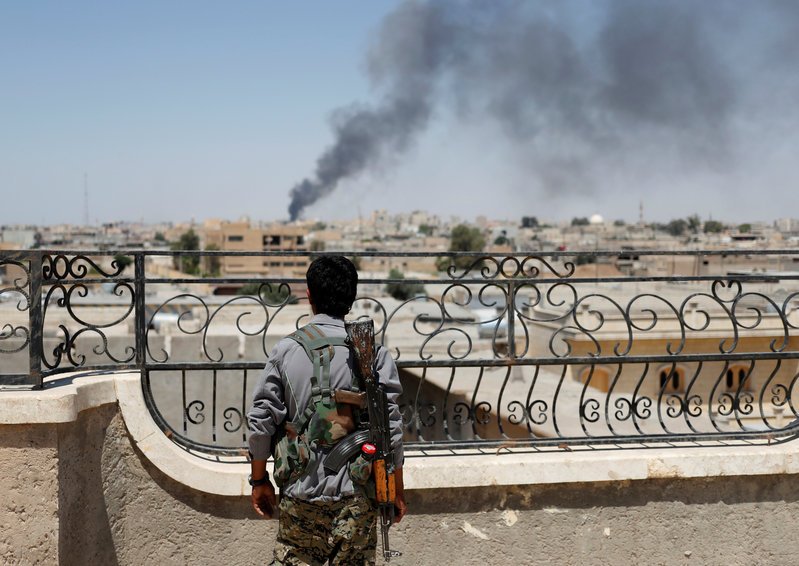
A Kurdish fighter from the People’s Protection Units (YPG) looks at smoke after a coalition airstrike in Raqqa, Syria, June 16, 2017. Credit: Reuters
These two forces have decimated the structures of the caliphate and killed or dispersed most of its fighters. Raqqa was subjected to massive aerial bombardment, with over 2,500 air strikes in just June and July that broke the ISIS ranks while also destroying large parts of the city and inflicting hundreds of civilian casualties. There are several hundred mines littered all over the town which continue to cause casualties among civilians and even military personnel.
The end of the caliphate has opened fresh sectarian, ethnic and political fault lines that will suffuse West Asia in harsh competitions and conflicts for years to come. Mustafa al-Said, writing in the Egyptian Al Ahram, has said: “As the time draws near for turning the last page on ISIS, gusting winds of change are blowing on the region.”
Kurdish aspirations
The main area of concern is that the outlook for Syria remains uncertain. Russia, in association with Iran and Turkey, is establishing “de-escalation zones” in different parts of the country as part of the peace process sponsored by them. But several parts of the country will remain areas of intense competition, emerging from the interests of contending regional players.
The most serious problem is the Kurdish attempt to consolidate its “Rojava”, the western homeland at the Syrian-Turkish border, in which it intends to include the freshly liberated town of Raqqa and possibly even Deir ez-Zour, near the border with Iraq. This is being fiercely opposed by Turkey and the Assad government in Damascus.
Turkey sees the Syrian Kurds as staunch allies of its own dissident Kurdistan Workers’ Party (PKK), with the prospective Rojava providing both strategic depth and sanctuary to PKK elements. Turkey, in association with the Assad forces, will therefore sternly oppose Kurdish claims both to the homeland and the inclusion of the arable areas of Raqqa and Deir ez-Zour in it, with military force, if necessary.
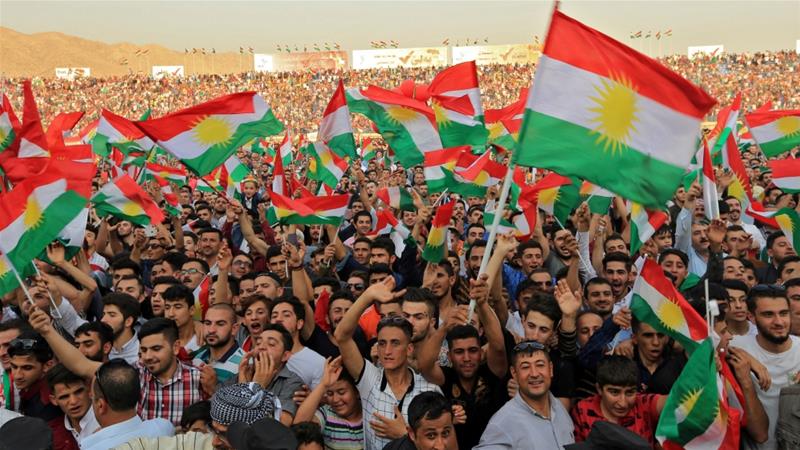
Kurdish people attend a rally to show their support for the independence referendum. Credit: Ari Jalal/Reuters
Turkey is expected to be emboldened in its opposition to Kurdish aspirations by the setbacks the Kurds have just suffered in Iraq. After winning the independence referendum, the Kurds had forcefully asserted their claim to the oil-rich, multi-ethnic town of Kirkuk. But here, Iraqi forces backed solidly by the pro-Iran PMUs, easily routed the Kurdish peshmerga, who vacated Kirkuk without much fighting.
While Kirkuk was being re-taken, the US, a staunch ally of the Kurds and supporter of its aspirations, did not intervene militarily or even politically on behalf of its protégé, having earlier criticised the referendum itself in strong terms for diverting attention from the main fight against ISIS. Turkey is confident that this position will be repeated in Syria as well.
The “Iran card”
The Syrian Kurds, however, believe that their position is quite different: in Syria, they enjoy full US backing on the battlefield, which they believe will continue in support of their long-held political aspirations, even if it means alienating the Turks.
In both Iraq and Syria, the Kurds are planning to play the Iran card to obtain US backing for their territorial ambitions: they are pointing out that thwarting their ambitions simply benefits Iran by further consolidating its influence in both Iraq and Syria. With President Trump having just announced a “comprehensive Iran strategy” that seeks to reduce Iran’s influence across West Asia, the Kurds believe they are on solid ground.
Also read: Three Ways Trump’s Nuclear Strategy Misunderstands the Mood in Iran
They also have strong support from sections of the US Congress which are concerned about the role of the Iran-backed PMU, with US weaponry, in the Kurdish defeat at Kirkuk. Senate Armed Services Committee chairman John McCain has called on Iraqi forces to “take immediate steps to de-escalate this volatile situation by ceasing their advances. I am especially concerned by media reports that Iranian and Iranian-backed forces are part of the assault. Make no mistake, there will be severe consequences if we continue to see American equipment misused in this way.”
But the Kurds could be disappointed: many observers believe that the Trump strategy on Iran is long on rhetoric, but woefully short on operational capacity; with the US reluctant to expand its military footprint in the quagmire of West Asian politics, Iran, with its regional allies, Turkey, Syria and Iraq, and the support of battle-hardened militia, Hezbollah and the PMUs, sees itself quite well-placed to hold its own in the region.
Of course, if the US president is encouraged to robustly confront Iran, as he is being egged on to do by Israel, Saudi Arabia and his right-wing backers at home, then the prospects of a larger confrontation become real, with even the possibility of military conflict.
This could take place in Syria, where the Iran-backed government troops are positioned in the south of Raqqa and are also racing towards Deir ez-Zour, which SDF elements, with their US mentors, are also seeking to take over. US defence secretary Jim Mattis has said that, while the US focus is still on ISIS, American officials will “watch for Iran’s destabilising movements and activities everywhere.”
Russian role in West Asia
Sections of the US Congress are also seeking a larger, better defined US role in West Asia; thus, Senator McCain, has said: “For far too long, the United States has approached the Middle East through the narrow vantage point of counterterrorism. What we need instead is a comprehensive strategy that takes all regional factors into account.” This raises the question of the likely Russian role in the scenario.
Russia started out in Syria in late 2015 as the solid military and political ally of the Assad regime to prevent externally-sponsored regime change in Damascus. Since then, its role has expanded, and Russia is now at the heart of all political and diplomatic activity in the region: President Vladimir Putin is the principal interlocutor for all regional leaders, including from Turkey, Iran, Israel, Egypt, Jordan, Iraq and most recently Saudi Arabia.
Russia’s central role in West Asian affairs emerged due to the absence of the US from the region during the Obama era; this is no longer the case. The Republican political establishment continues to view Russia as its principal global strategic rival and is not willing to yield space to Putin in West Asia. With the US’s enlarged and largely successful role in defeating ISIS in Iraq and Syria, there is no reason to believe that its forward movement will now be halted: given the anti-Iran frenzy in Washington, US forces are likely to seek every opportunity to roll back Iran’s presence in Iraq and Syria, with full backing from its regional allies, Israel and Saudi Arabia.
In fact, in Syria itself a deep divide between the US and Russia has now emerged: Russia has said that the US was largely responsible for the killing of its general, Valery Asapov, by ISIS at Deir ez-Zour on September 25; it accuses the US of not focusing on destroying ISIS but following a “two-faced” policy. Some Russian sources are even blaming the US for providing ISIS the coordinates that enabled it to target the general so accurately.
What is thus emerging after the fall of Raqqa is a major re-alignment of the regional balance of power, with the US, backed by Israel and Saudi Arabia, confronting Russia, which is allied with Turkey and Iran, the latter buttressed by its own militant allies.
Competing interests
However, the unfolding scenario may not actually be so clear-cut. The Saudi outreach to Moscow with the visit of King Salman to Moscow in October and the conclusion of defence, energy, economic and technological agreements between them, suggests that Saudi confidence in the US administration’s capacity to deliver on its promises remains low. In contrast, Putin is seen across West Asia as one who stands by his allies and delivers on his commitments.
This means a lot to all the major regional players: the kingdom needs Russian help to extricate itself from its Yemen and Syrian imbroglios; Turkey wants to ensure that Kurdish aspirations are checked; Iran wishes to see Assad in power and its influence in Iraq and Syria undiminished, while Israel wants Iran and Hezbollah contained in Syria.
Developments in Syria will reveal how these competing interests of regional players are reconciled by Russia. In spite of the violence and blood-letting of the last few years, the outcome could be positive. Despite the anxieties in Washington, Russia remains at the heart of the Syrian peace process, with its lead role in steering discussions at Astana, the peace plans it has put on the table, and, above all, the fact that Saudi Arabia has now recognised the need to back the Russian initiative.
The kingdom has agreed to the various Syrian opposition factions coming together and accepting the fact that Assad will remain in power during the (undetermined) “transition” period. It has also accepted that a new political order will be shaped for the country which will accommodate various political aspirations, ethnic and sectarian, in a federal system that retains the traditional boundaries and formal sovereignty of the nation.
Israel’s prime minister, Benjamin Netanyahu, has also seen much merit in engaging with Putin, having visited Moscow four times in the last 18 months, attesting to Russia’s pivotal role in ensuring its security. Putin has offered Netanyahu a five-km buffer zone at the Syria-Israel border which will be free of Iranian and Hezbollah forces, and has not objected too strenuously when Israel has launched cross-border air attacks on Hezbollah positions that are viewed as threatening Israel. He has, however, firmly rejected Israel’s efforts to create a divide between Russia and Iran.
The outlook for West Asian stability will thus be determined by Russia’s ability to deliver on its commitments and the ability of US and Russia to work together as equal partners. The alternative scenario is for the US to assert its traditional hegemonic role in regional affairs in competition with Russia and to confront Iran, even if it means a direct conflict or, more realistically, enhanced sanctions and heightened pressures to promote regime change, a vision that enthuses the US right-wing most robustly.
Whither ISIS?
While the principal regional and extra-regional powers jostle for influence, trans-national jihad remains a potent threat in West Asia. In an interview in July this year, Brett McGurk, the US diplomat who is heading the anti-ISIS operations in Iraq and Syria, said that, while terrorist acts by jihadis would continue after the defeat of ISIS, the latter’s capacity to regenerate itself as a military force had ended.
However, the continuing threat of extremist violence remains very real. After the victory parade in Raqqa, it emerged that only 45% of the city had been liberated, and several pockets of resistance remained. More ominously, hundreds of mines, explosives and suicide vests have been discovered, suggesting that the remaining jihadis are well-equipped to inflict considerable damage on soft targets.
The most likely targets will be states experiencing civil conflict and breakdown of state authority, such as Iraq, Syria, Yemen, Somalia, Libya, parts of Nigeria and the Sinai Peninsula in Egypt, which jihadis penetrate with impunity, and, through suicide bombings, inflict considerable damage on the civilian population. It is noteworthy that in Syria and Iraq, where ISIS has experienced significant setbacks, it is still able to carry out lethal bombings in Damascus and Baghdad.
The allure of jihad is strengthened by the fact that civil conflicts and external interventions in Syria, Yemen and Libya have destroyed all infrastructure of governance and civic life, leaving hundreds of thousands of people displaced and destitute. Thus, several thousand of Raqqa’s residents are displaced, most of them eking out a miserable existence in inadequately funded and poorly organised makeshift camps. While the US and its allies are focused on war, they have little interest in re-construction and nation-building projects, so that “liberated” towns can become recruiting spaces for new jihadis.
Besides weak central authority in many Arab states in conflict, sectarian and ethnic divisions, assiduously promoted by regional states and local forces for political advantage, will also ensure that jihadi groups continue to attract youth propelled by a sense of grievance and victimhood. For instance, in the ongoing fighting against the remnants of ISIS cadres in Iraq, a lead role is being played by the largely Shia PSUs, some of which are carrying out mopping up operations while using prominent Shia symbols and slogans. These are bound to encourage some Sunni youth in the country to join jihadi groups.
The most dangerous aspect of jihadi violence is the role of lone-wolf actors who perpetrate extraordinary violence on soft targets in different parts of the world, particularly Europe. Their earlier activities do not indicate any direct association with jihadi groups; they seem to be indoctrinated through social media. Though several lone-wolf attacks have taken place in western countries, no clear profile of the perpetrators has emerged that would enable security experts to pre-empt their attacks.
At the end of Abdel Bari Atwan’s outstanding study of ISIS, Islamic State: The Digital Caliphate, the author had quoted former CIA chief, Leon Panetta, as saying: “I think we’re looking at kind of a 30-year war … one that will extend beyond Islamic State to include emerging threats in Nigeria, Somalia, Yemen, Libya and elsewhere.”
This seems to be a very likely prospect.
Talmiz Ahmad, a former diplomat, holds the Ram Sathe Chair for International Studies, Symbiosis International University, Pune and is Consulting Editor, The Wire.


